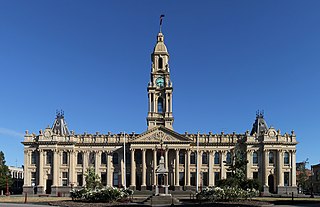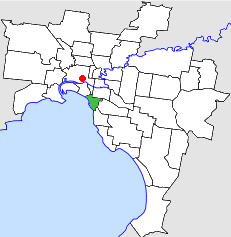
St Kilda East is a suburb in Melbourne, Victoria, Australia, 6 km south-east of Melbourne's Central Business District, located within the Cities of Glen Eira and Port Phillip local government areas. St Kilda East recorded a population of 12,571 at the 2021 census.

North Melbourne is an inner-city suburb in Melbourne, Victoria, Australia, 3 km (1.9 mi) north-west of Melbourne's Central Business District, located within the City of Melbourne local government area. North Melbourne recorded a population of 14,953 at the 2021 census.

State Library Victoria (SLV) is the state library of Victoria, Australia. Located in Melbourne, it was established in 1854 as the Melbourne Public Library, making it Australia's oldest public library and one of the first free libraries in the world. It is also Australia's busiest public library and, as of 2023, the third busiest library globally.

Fitzroy is an inner-city suburb in Melbourne, Victoria, Australia, 3 km (1.9 mi) north-east of Melbourne's Central Business District, located within the City of Yarra local government area. Fitzroy recorded a population of 10,431 at the 2021 census.

Melbourne Town Hall, often referred to as simply Town Hall, is the administrative seat of the local municipality of the City of Melbourne and the primary offices of the Lord Mayor and city councillors of Melbourne. Located on the northeast corner of Swanston and Collins street in the central business district of Melbourne, Victoria, Australia, the building was completed in 1887 and heritage listed on the Victorian Heritage Register in 1974. The building is frequently used for art and cultural events such as concerts, festivals, theatrical plays and exhibitions.

Parliament House is the meeting place of the Parliament of Victoria, one of the parliaments of the Australian states and territories.

The Queen Victoria Market is a major landmark in the central business district (CBD) of Melbourne, Victoria, Australia. Covering over seven hectares, it is the largest open air market in the Southern Hemisphere.

Joseph Reed, a Cornishman by birth, was a prolific and influential Victorian era architect in Melbourne, Australia. He established his practice in 1853, which through various partnerships and name changes, continues today as Bates Smart, one of the oldest firms continually operating in Australia.

East Melbourne is an inner-city suburb in Melbourne, Victoria, Australia, 2 km (1.2 mi) east of Melbourne's Central Business District, located within the City of Melbourne local government area. East Melbourne recorded a population of 4,896 at the 2021 census.

The Bryant and May Factory, located in the Cremorne area of Richmond in Melbourne, is notable for its distinctive red brick buildings, and as the location for the manufacture of Australia's most popular brand of matches through much of the 20th century. Bryant and May adopted the brand name Redheads in 1946, and it is still the most popular match in the country, although now manufactured in Sweden.

The Athenaeum or Melbourne Athenaeum at 188 Collins Street is an art and cultural hub in the central business district of Melbourne, Victoria, Australia. Founded in 1839, it is the city's oldest cultural institution.

A coffee palace was an often large and elaborate residential hotel that did not serve alcohol, most of which were built in Australia in the late 19th century.

South Melbourne Town Hall is a landmark civic building located on Bank Street in South Melbourne, a suburb of Melbourne, Victoria, Australia. It is listed on the Victorian Heritage Register as of state heritage significance to Victoria.
Australian non-residential architectural styles are a set of Australian architectural styles that apply to buildings used for purposes other than residence and have been around only since the first colonial government buildings of early European settlement of Australia in 1788.

Edwardian architecture usually means a Neo-Baroque architectural style that was popular for public buildings in the British Empire during the Edwardian era (1901–1910). Architecture up to 1914 is commonly included in this style.

The City of St Kilda was a local government area on Port Phillip, about 5 kilometres (3.1 mi) south of Melbourne, the state capital of Victoria, Australia. The city covered an area of 8.70 square kilometres (3.36 sq mi), and existed from 1855 until 1994.

The architecture of Melbourne, the capital of the state of Victoria and second most populous city in Australia, is characterised by a wide variety of styles in various structures dating from the early years of European settlement to the present day. The city is particularly noted for its mix of Victorian architecture and contemporary buildings, with 74 skyscrapers in the city centre, the most of any city in the Southern Hemisphere.

The St. Moritz Ice Rink, built as the Wattle Path Palais de Danse in 1923 and then used as Efftee Studios from 1933, was an ice rink on The Esplanade, St. Kilda, Victoria, which operated between 1939–1981. Opened as St. Moritz Ice-skating Palais, as one of only two ice rinks in Melbourne in the 40s and 50s, it played a central role to the sport of ice hockey in Australia. Closed in 1982, it soon suffered a major fire and was then demolished, an event later seen as a major blow to the heritage of St Kilda.
The Town of North Melbourne was a local government area in Victoria, Australia, centred on the suburb of North Melbourne.

















